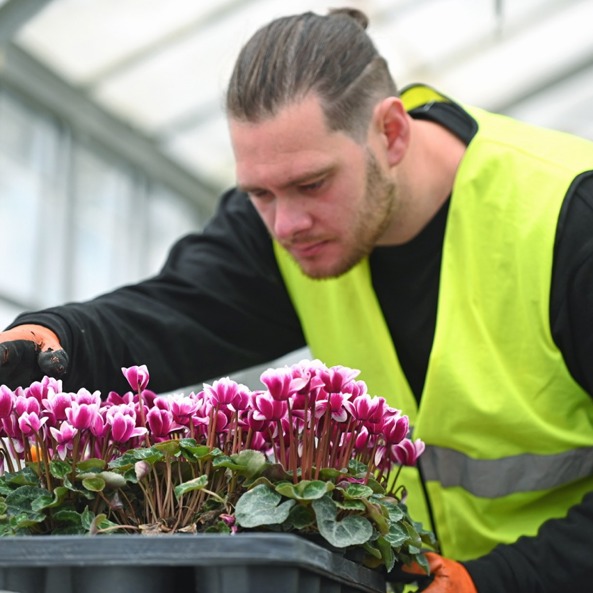We’ve all experienced or heard of a hosepipe ban at some point in our lives.
They can be quite annoying for people with large gardens, or for companies with a lot of outdoor landscaping. However, they are also an important reminder of climate change and water efficiency, something that is getting more and more important by the day.
With temperatures rising across the board, local authorities are likely to implement more and more restrictions in the future.
As the UK’s leading provider of outdoor landscaping and grounds maintenance, we are constantly keeping on top of this, allowing our clients’ lush, green outdoor areas while also minimising water usage.
Today, we are sharing some of this knowledge with you in order to help us all be more water-efficient and improve the situation for the future:
Water Saving Tips for Individuals & Organisations
Plan for Water Efficiency from the Start with Drought Tolerant Plants
Many plants with low water requirements are available. Some of these are obvious, such as cacti, aloe, and succulents, but there are many others that you are likely unaware of. From coneflowers and lavender to sage, yarrow and California poppy, there are many plants that both deal well with less watering, and are also more tolerant of mid-summer hot weather.
By planning water efficiency from the start and focusing your outdoor space on these types of plants, you can make dramatic reductions in the amount of water needed in the long term, while also reducing maintenance costs and plant loss.
Water Efficiently
It’s important to remember that for the vast majority of plants, water is absorbed via the roots. In most cases, water elsewhere does not benefit the plant at all - so showering leaves, stems, and flowers is a complete waste of water and time. Equally, vaguely placed sprinklers and irrigation systems that water “in the general area” of plants and even onto lawns and other areas empty of plants - is only going to waste water daily, pumping it into areas it isn’t needed.
If you’re watering manually - pour or spray water gently directly at the roots and soak them well, shifting foliage if needed to get direct access to the plants “footprint”.
Another important factor is evaporation. If you water plants during one of the hottest parts of the day, a large amount of the water will evaporate without ever reaching the plant’s roots. This is very wasteful, and it is a lot more efficient to water at dawn and/or dusk during the hottest parts of the year, allowing the plants to slowly absorb the water without evaporation loss while the air is cooler.

Use Effective Mulching
Compost, wood chips, straw, or purpose-made mulch products will dramatically improve water efficiency. They will shelter the surface of the soil from the sun, making it dry out much slower. They will also absorb moisture when it rains or you water the plants, slowly leaking it into the soil over a much longer time period than usual. These effects combine to make your water go much further. Most mulches are also rich in nutrients which leak into the soil along with the water, reducing the amount of fertiliser needed and helping to keep plants healthy.
Let the Lawn Dry Out!
Many people water their lawns daily just like other plants, assuming this is necessary to keep them green and healthy. This is not true at all, and in most cases watering a lawn daily will be a waste of water. Grass can tolerate a spell of drought, as long as it isn’t too long - and if you do decide to water your lawn, once or twice a week is more than enough.
Short grass is less drought-tolerant, so allowing it to grow a little longer will help with this.
Minimise use of Hosepipes and Find More Efficient Techniques
There are many watering techniques more efficient than a simple hosepipe. From commercial rainwater irrigation systems that recycle rainfall directly into the soil, to much more simple options such as watering cans.
If you do decide to use a hosepipe regardless, one with a trigger nozzle will reduce usage dramatically compared to one that is constantly on - ensuring water is only ejected from the hose when it is going to benefit a plant.
Use the Right Pots & Containers
This point is easily overlooked, but surprisingly effective. For example, plastic pots both prevent rainwater from absorbing through the side of the pot, and get very warm in heat. This is, even more, the case for black pots, which can absorb sunlight and get very hot very quickly. Smaller pots and containers also dry out more easily as they contain less soil to hold onto the moisture. If a plant is in a small, black, plastic pot and in direct sun with no shelter, you can expect it to quickly dry out every time there is a warm day.
On the other hand, terracotta allows rainwater to be absorbed through the side of the pot directly into the soil, and is also a lot more breathable than plastic. Lightly coloured terracotta pots will keep soil moist for longer, prevent the soil from heating up too much, and reduce your watering needs.

Need Help?
phs Greenleaf is the UK’s leading supplier of hanging baskets for pubs and stores, corporate plants for offices, outdoor landscaping, grounds maintenance, invasive plant removal and more. To get help with your commercial gardening needs or to spruce up any outdoor area, consider getting in touch now!

























